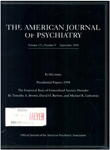Obsessions in obsessive-compulsive disorder with and without Gilles de la Tourette's syndrome
Abstract
OBJECTIVE AND METHOD: Although obsessive-compulsive disorder commonly occurs in many patients with Gilles de la Tourette's syndrome, little is known about the obsessions and compulsions of Tourette's syndrome and whether they differ from those seen in pure obsessive-compulsive disorder. The authors prospectively studied 10 subjects with obsessive- compulsive disorder and 15 subjects with obsessive-compulsive disorder and comorbid Tourette's syndrome by using the Yale-Brown Obsessive Compulsive Scale, the Leyton Obsessional Inventory, and a new questionnaire designed to emphasize the differences in symptoms between these two groups. RESULTS: Subjects with comorbid obsessive-compulsive disorder and Tourette's syndrome had significantly more violent, sexual, and symmetrical obsessions and more touching, blinking, counting, and self-damaging compulsions. The group with obsessive- compulsive disorder alone had more obsessions concerning dirt or germs and more cleaning compulsions. The subjects who had both disorders reported that their compulsions arose spontaneously, whereas the subjects with obsessive-compulsive disorder alone reported that their compulsions were frequently preceded by cognitions. CONCLUSIONS: There are phenomenologic differences between obsessive-compulsive disorder and obsessive-compulsive disorder with comorbid Tourette's syndrome that may reflect differential involvement of neurochemical and neuroanatomic pathways.
Access content
To read the fulltext, please use one of the options below to sign in or purchase access.- Personal login
- Institutional Login
- Sign in via OpenAthens
- Register for access
-
Please login/register if you wish to pair your device and check access availability.
Not a subscriber?
PsychiatryOnline subscription options offer access to the DSM-5 library, books, journals, CME, and patient resources. This all-in-one virtual library provides psychiatrists and mental health professionals with key resources for diagnosis, treatment, research, and professional development.
Need more help? PsychiatryOnline Customer Service may be reached by emailing [email protected] or by calling 800-368-5777 (in the U.S.) or 703-907-7322 (outside the U.S.).



